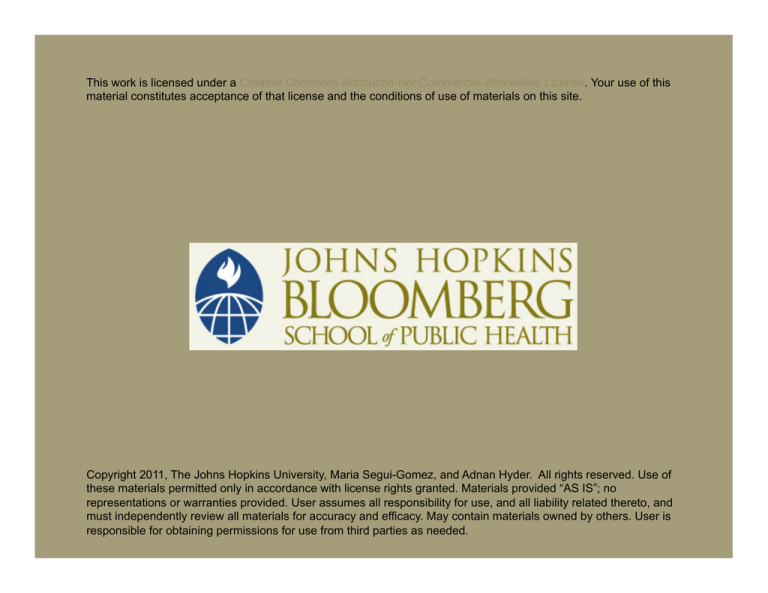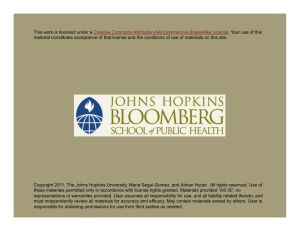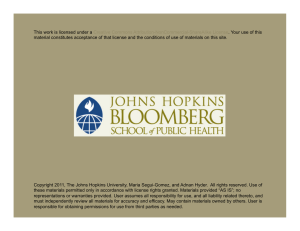
This work is licensed under a Creative Commons Attribution-NonCommercial-ShareAlike License. Your use of this
material constitutes acceptance of that license and the conditions of use of materials on this site.
Copyright 2011, The Johns Hopkins University, Maria Segui-Gomez, and Adnan Hyder. All rights reserved. Use of
these materials permitted only in accordance with license rights granted. Materials provided “AS IS”; no
representations or warranties provided. User assumes all responsibility for use, and all liability related thereto, and
must independently review all materials for accuracy and efficacy. May contain materials owned by others. User is
responsible for obtaining permissions for use from third parties as needed.
Events and Exposure
Adnan Hyder, MD, PhD
Maria Segui-Gomez, MD, MPH, ScD
Johns Hopkins University
Lecture Topics
Describing and quantifying injurious events
Measuring exposure
Identifying and quantifying risk factors
Case study
3
Section A: Describing and Counting Events
Maria Segui-Gomez, MD, MPH, ScD
What Do We Mean by Events?
Situations where energy is being released in either greater or
smaller amounts than ordinary, in less than an ordinary
amount of time, or both
Circumstances that could lead to personal injuries (regardless
of whether they actually occur)
- For example, car or airplane, crashes, fires, falls
5
Relevance of Events Data
Necessary to understand circumstances leading to fatal or
nonfatal injuries
- Helps identify circumstances (or aspects of circumstances)
that could be addressed by injury prevention programs
6
Relevance of Events Data
Necessary to understand circumstances leading to fatal or
nonfatal injuries
- Key for secondary injury prevention planning
- There is a lot that can be learned from events that do not
lead to injuries despite the fact that they look like other
events where injuries occurred
7
Events
Used as numerators
- There were 6,335,000 crashes in the U.S. in 1998
Used as denominators
- 0.6% of motor vehicle crashes lead to at least one death
(41,471 deaths/6,335,000 crashes)
8
Data Sources
Multiple
- Police reports
Car crashes—normally there is a minimum amount of
damage required before reporting
Home robberies
- Firefighter records (e.g., fires)
- Nursing home records (e.g., falls among elderly)
9
Data Sources
Personal surveys (e.g., recreational injuries)
And all the same sources where the injuries are reported
10
Data Coding
Events that lead to injuries
We have listed the most frequent ones in mortality and
morbidity sessions
For example
- International Classification of Diseases (E codes in the 9th
version), NOMESCO Classification of External Causes of
Injuries, New Zealand, Australian codes, International
Classification of External Causes of Injury (ICECI)
11
Data Coding
Events
- Other multiple data system-specific codes
12
Event Data Comparability
Beware of
- Data source variability
- Case identification variability
Normally there is a minimum physical/economic
damage amount used to define the event as
reportable, but that can vary
- Coding system variability
13




